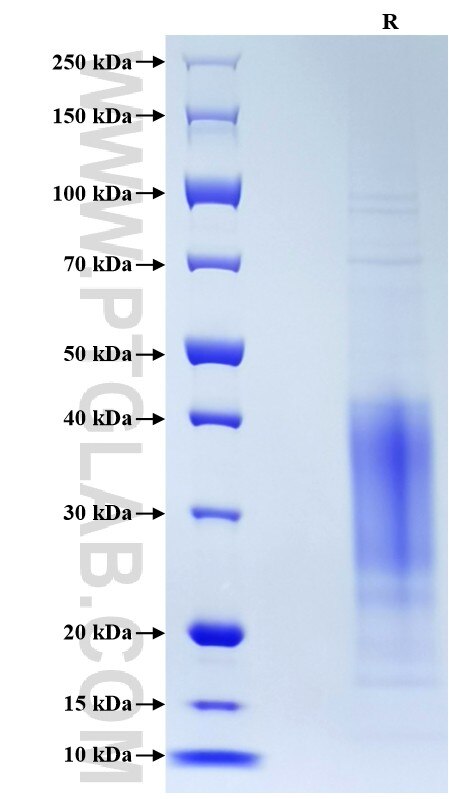Recombinant Human IL-13 protein (Myc Tag, His Tag)
Species
Human
Purity
>90 %, SDS-PAGE
Tag
Myc Tag, His Tag
Activity
not tested
Cat no : Eg0061
Validation Data Gallery
Product Information
| Purity | >90 %, SDS-PAGE |
| Endotoxin | <0.1 EU/μg protein, LAL method |
| Activity |
Not tested |
| Expression | HEK293-derived Human IL-13 protein Gly21-Asn132 (Accession# AAK53823) with a Myc tag and a His tag at the C-terminus. |
| GeneID | 3596 |
| Accession | AAK53823 |
| PredictedSize | 17.9 kDa |
| SDS-PAGE | 22-45 kDa, reducing (R) conditions |
| Formulation | Lyophilized from 0.22 μm filtered solution in PBS, pH 7.4. Normally 5% trehalose and 5% mannitol are added as protectants before lyophilization. |
| Reconstitution | Briefly centrifuge the tube before opening. Reconstitute at 0.1-0.5 mg/mL in sterile water. |
| Storage Conditions |
It is recommended that the protein be aliquoted for optimal storage. Avoid repeated freeze-thaw cycles.
|
| Shipping | The product is shipped at ambient temperature. Upon receipt, store it immediately at the recommended temperature. |
Background
Interleukin 13 (IL-13) is an immunoregulatory cytokine produced primarily by activated Th2 cells. This cytokine is involved in several stages of B-cell maturation and differentiation. IL-13 up-regulates CD23 and MHC class II expression, and promotes IgE isotype switching of B cells. IL-13 inhibits the production of a series of cytokines like IL-1, IL-6, TNF-alpha, and IL-8 by activated human monocytes. IL-13 induces IFN-gamma production by NK cells. IL-13 is thought to be important cytokine in the pathogenesis of asthma, and more recently has been shown to play a pivotal role in a number of fibrotic diseases including hepatic and pulmonary fibrosis, and nodular sclerosing Hodgkin's disease.
References:
1.Wynn, Thomas A et al. Annual review of immunology vol. 21, (2003): 425-56. 2.Izuhara, K et al. Current medicinal chemistry vol. 13,19 (2006): 2291-8. 3.Ma, Qin et al. Allergologia et immunopathologia vol. 50,6 (2022): 22-31. 4.O'Reilly, Steven et al. BioFactors (Oxford, England) vol. 39,6 (2013): 593-6.

